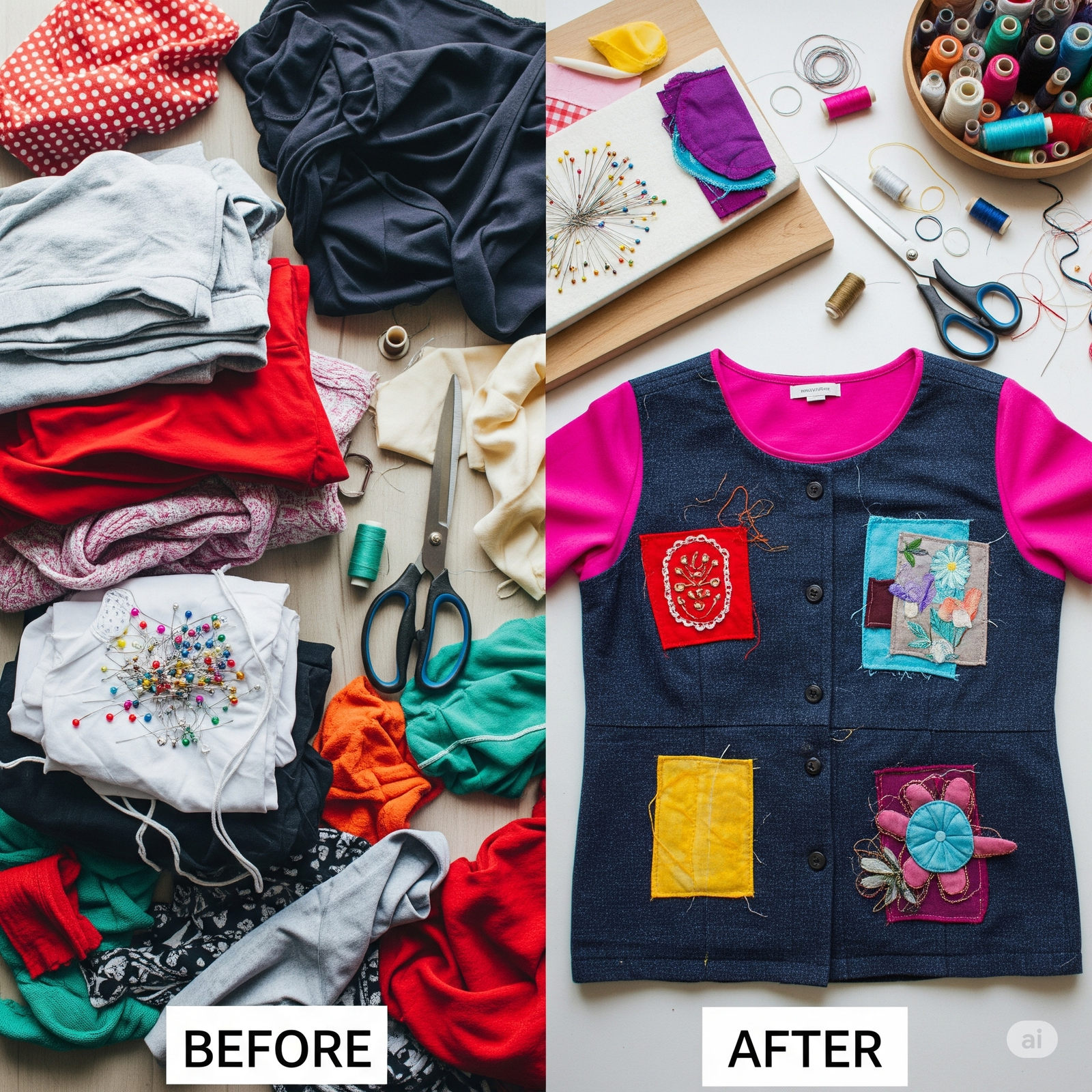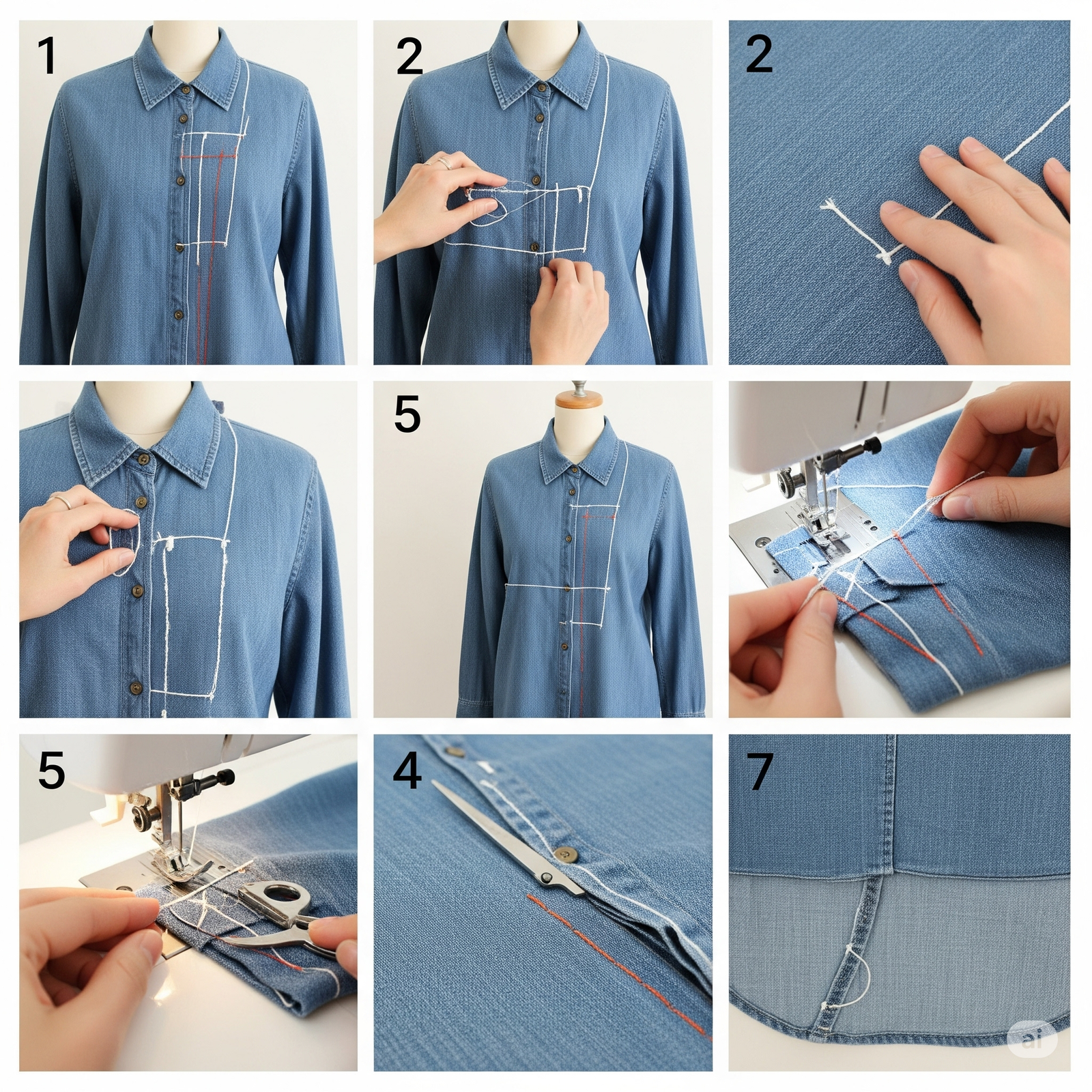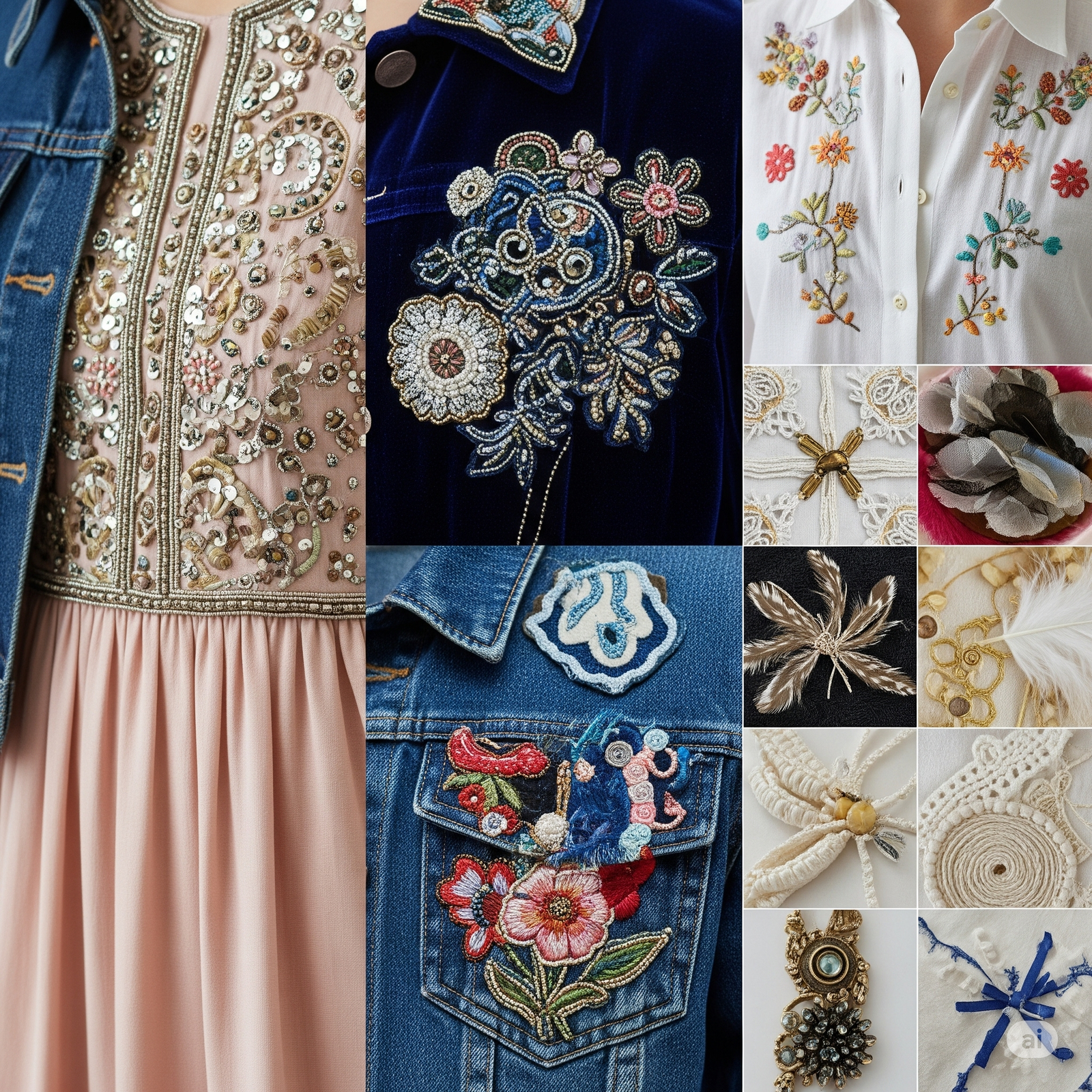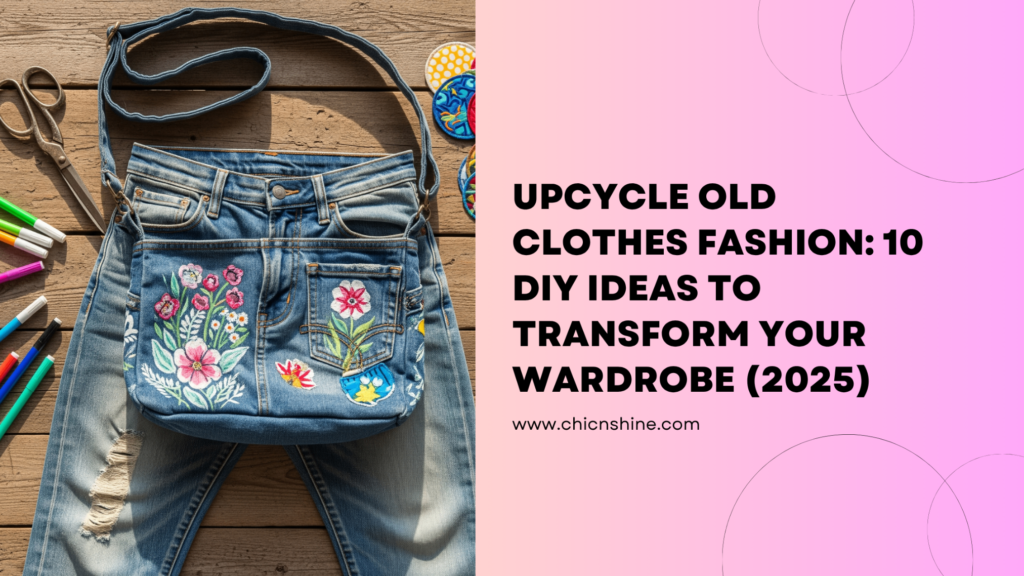Staring at my overflowing closet last spring, feeling overwhelmed by clothes I never wore but couldn’t bear to throw away, I discovered the transformative world of upcycle old clothes fashion that would completely revolutionize my relationship with sustainable style. What began as a desperate attempt to declutter became an incredibly fulfilling creative journey that not only saved me money but also helped me develop a unique personal aesthetic while contributing to environmental conservation in the most practical way possible.

My Journey Into Sustainable Fashion Transformation
The moment that changed everything happened when I found my grandmother’s vintage sewing box in the attic, filled with buttons, threads, and tiny scissors that had created countless beautiful garments over decades. Holding those well-worn tools, I realized that the art of transforming clothes had been practiced by generations of women who understood that creativity and resourcefulness could turn the ordinary into something extraordinary.
My first upcycling project was admittedly disastrous—I attempted to transform an old maxi dress into a trendy crop top and ended up with something that looked more like a medieval tunic than contemporary fashion. However, that failure taught me the importance of planning, measuring, and understanding fabric behavior before making irreversible cuts. More importantly, it showed me that mistakes are simply part of the creative process.
The breakthrough came when I successfully transformed a dated button-down shirt into a stylish off-shoulder top by repositioning the neckline and adding gathered elastic at the shoulders. The compliments I received when wearing that piece convinced me that upcycle old clothes fashion could produce results that rivaled expensive boutique purchases while carrying the added satisfaction of personal creation.
The Art of Deconstructing to Reconstruct
Learning to see garments as collections of fabric pieces rather than fixed entities has been fundamental to my success with clothing upcycling. When I look at an old dress now, I see potential sleeve fabric, skirt panels that could become scarves, or button details that might enhance other projects. This perspective shift transforms every unworn garment into a treasure trove of possibilities.
The deconstruction process requires patience and strategic thinking. I’ve learned to carefully remove seams using a seam ripper, preserving as much fabric as possible while understanding how the original garment was constructed. This knowledge becomes invaluable when reimagining pieces into new configurations that maintain professional-looking finishes.
Reddit User Query: “What tools do I need to start upcycling clothes at home?” Based on my experience, essential tools include sharp fabric scissors, a seam ripper, measuring tape, pins, basic sewing supplies, and either a sewing machine or strong hand-sewing skills. Start with simple projects before investing in specialized equipment.
My most successful transformations have come from understanding fabric properties and working with rather than against natural drape and stretch. Cotton shirts behave differently than silk blouses when cut and resewn, and acknowledging these differences leads to more successful outcomes that look intentional rather than crafted from desperation.
Transform Oversized Pieces Into Perfect Fits
The first transformative technique that revolutionized my approach to upcycle old clothes fashion involves turning oversized garments into perfectly fitted pieces that flatter your body type. My collection of inherited and thrifted oversized pieces became the foundation for countless successful projects that created clothes I actually wanted to wear.
My favorite transformation involves converting oversized men’s shirts into feminine, fitted pieces by taking in the sides, shortening sleeves, and adding waist definition through strategic seaming. The structured shoulders and quality fabric of men’s shirts often surpass women’s alternatives, making them excellent candidates for creative alteration.

The technique extends beautifully to dresses and jackets. An oversized blazer can become a perfectly tailored piece through side seam adjustments and sleeve modifications. Similarly, shapeless vintage dresses gain new life when fitted properly and updated with contemporary styling details.
Creative Color and Pattern Additions
The second game-changing approach involves using fabric paints, dyes, and additional materials to completely transform the aesthetic of existing pieces. My boring collection of plain t-shirts became a canvas for creative expression through tie-dye techniques, fabric painting, and strategic appliqué work that created unique pieces impossible to find in stores.
Bleach techniques have produced some of my most striking transformations. By strategically applying bleach in patterns or ombré effects, I’ve turned dark, dated pieces into trendy, contemporary garments with distinctive visual appeal. The unpredictable nature of bleach work ensures that each piece becomes truly one-of-a-kind.
Quora Question: “Is it safe to use bleach and fabric dyes at home?” Always work in well-ventilated areas, wear protective clothing and gloves, and test techniques on fabric scraps first. Follow product instructions carefully and consider the environmental impact of chemical disposal.
Block printing and stenciling techniques have allowed me to add professional-looking patterns to plain garments. Using carved potatoes, foam shapes, or purchased stencils, I’ve created geometric patterns, floral designs, and abstract motifs that transform basic pieces into statement garments that reflect my personal aesthetic.
Embellishment Magic That Elevates Everything
The third revolutionary technique involves using embellishments to transform plain or dated pieces into contemporary statement garments. My collection of buttons, beads, sequins, and patches has grown into a treasure trove of possibilities that can elevate any basic garment into something special and unique.
Strategic beadwork has transformed several plain evening dresses into glamorous pieces suitable for special occasions. The key lies in understanding balance and placement—adding embellishments where they enhance the garment’s natural lines rather than overwhelming the overall design. Additionally, choosing embellishments that complement rather than compete with fabric colors ensures cohesive results.

Patch application has become one of my favorite ways to update denim pieces and casual wear. Vintage patches, embroidered designs, and even pieces cut from other garments can create interesting visual focal points while covering stains or worn areas. The eclectic mix of patches tells a story and creates conversation pieces that reflect personal interests and aesthetic preferences.
Length and Silhouette Modifications
The fourth transformative approach focuses on dramatically changing garment proportions to create entirely new silhouettes that feel contemporary and intentional. My success with hemline adjustments, sleeve modifications, and neckline changes has proven that small alterations can produce major visual impact.
Converting long dresses into midi or mini lengths has breathed new life into pieces that felt dated due to their original proportions. The key lies in understanding how different lengths work with your body type and personal style preferences. Additionally, the fabric removed from hemming projects often provides material for other creative endeavors.
Sleeve modifications offer incredible versatility for updating dated pieces. Converting long sleeves to three-quarter length, adding bell-shaped flares, or creating cold-shoulder cutouts can completely modernize older garments. Similarly, removing sleeves entirely and adding interesting neckline details creates contemporary tank tops from dated blouses.
Mixed Media and Fabric Combining
The fifth innovative technique involves combining different garments to create hybrid pieces that incorporate the best elements of each original item. My most successful projects have married the perfect fit of one garment with the beautiful fabric or details of another, creating pieces that exceed the sum of their parts.
Color-blocking techniques using fabric from multiple garments have produced some of my most striking results. By combining complementary or contrasting fabrics in geometric patterns, I’ve created contemporary pieces that look professionally designed rather than home-crafted. The key lies in understanding color theory and choosing combinations that feel intentional rather than random.

Texture mixing has opened up endless possibilities for creating interesting visual and tactile contrasts. Combining smooth silk with rough denim, delicate lace with sturdy cotton, or flowing chiffon with structured wool creates dynamic pieces that engage multiple senses while showcasing creative vision.
Accessories Creation From Clothing Scraps
The sixth brilliant approach involves transforming clothing remnants and unwearable pieces into fashionable accessories that complement updated wardrobes. My collection of scarves, headbands, belts, and bags created from upcycled clothing has become an essential part of my sustainable fashion practice.
Scarf creation from various fabric sources has proven endlessly versatile. Silk from damaged blouses, cotton from outgrown dresses, and even wool from sweaters beyond repair have all been transformed into beautiful scarves that add color and texture to simple outfits. The variety of fabrics ensures that I have appropriate scarves for every season and occasion.
Online Forum Discussion: “What can I do with clothes that are too damaged to wear?” Even heavily damaged clothes can provide fabric for accessories, patch material for other projects, cleaning rags, or stuffing for crafts. Very little needs to be completely wasted when you approach upcycling creatively.
Belt creation from leather jackets, sturdy fabric strips, or braided materials has provided unique accessories that perfectly match specific outfits. Creating custom belts ensures proper fit and desired aesthetic while utilizing materials that might otherwise be discarded.
Advanced Reconstruction Techniques
The seventh sophisticated approach involves completely deconstructing garments and reconstructing them into entirely different clothing categories. My transformation of old jeans into structured blazers, dresses into separates, and coats into vest-and-skirt combinations represents the most advanced level of upcycling creativity.
Pattern-making skills have become essential for these complex transformations. Learning to create paper patterns from existing garments and modify them for new purposes has opened up unlimited possibilities for creative reconstruction. Additionally, understanding construction techniques ensures that rebuilt garments maintain professional finishes and durability.
The most rewarding aspect of advanced reconstruction lies in creating pieces that perfectly suit your lifestyle and aesthetic preferences. Instead of searching stores for ideal garments, you can create exactly what you envision using materials and techniques that align with sustainable fashion values.
Seasonal Adaptation Projects
The eighth creative strategy focuses on adapting garments for different seasons through strategic modifications that extend their wearability throughout the year. My success with converting summer dresses into winter pieces through layering elements and fabric additions has maximized the value of every garment in my collection.
Sleeve addition techniques have transformed sleeveless summer pieces into appropriate autumn and winter wear. Using complementary fabrics or contrasting materials, I’ve added full sleeves, three-quarter lengths, or dramatic bell shapes that completely change the seasonal appropriateness of existing garments.

Similarly, shortening heavy winter pieces for summer wear has created lightweight versions that maintain the style elements I love while providing appropriate comfort for warmer weather. These adaptations ensure that favorite design details can be enjoyed year-round through thoughtful modification.
Technology Integration in Modern Upcycling
The ninth contemporary approach involves using modern technology and techniques to enhance traditional upcycling methods. My experimentation with heat transfer vinyl, digital printing on fabric, and laser cutting services has opened up professional-level possibilities for home upcycling projects.
Heat transfer vinyl application has allowed me to add professional-looking graphics, text, and designs to plain garments. This technique works particularly well for creating personalized pieces or adding contemporary design elements to vintage finds. Additionally, the durability of quality vinyl ensures that decorative elements withstand regular washing and wear.
Digital fabric printing services have enabled me to create custom prints using personal photographs or designs, incorporating them into upcycled pieces for truly unique results. This technology bridges the gap between home crafting and professional design capabilities.
Community and Skill Sharing
The tenth valuable approach involves connecting with other upcycling enthusiasts to share techniques, materials, and inspiration. My participation in online communities, local crafting groups, and skill-sharing meetups has exponentially increased my knowledge and creative possibilities while building meaningful connections with like-minded individuals.
Clothing swap events have become excellent sources for raw materials while providing opportunities to share finished projects and gather feedback from other creative individuals. These gatherings often lead to collaborative projects and knowledge exchange that benefits everyone involved.
Reddit Community Insight: “The best upcycling ideas come from seeing what others have created and adapting their techniques to your own style and available materials.”
Teaching upcycling techniques to friends and family members has reinforced my own learning while spreading sustainable fashion practices within my community. The satisfaction of helping others discover their creative potential while reducing textile waste creates positive impact beyond personal benefits.
The Economics of Fashion Upcycling
Understanding the financial benefits of upcycle old clothes fashion has been crucial to maintaining motivation and justifying the time investment required for successful projects. My detailed tracking of costs versus retail equivalents has proven that upcycling provides significant economic advantages while delivering superior quality and perfect fit.
The initial investment in quality tools and supplies pays for itself quickly through reduced clothing purchases and extended garment lifespans. Additionally, the skills developed through upcycling enable repairs and modifications that further extend the life of all clothing, creating ongoing financial benefits.
The psychological satisfaction of wearing unique, personally created pieces adds intangible value that cannot be replicated through conventional shopping. This emotional connection to clothing reduces impulse purchases and promotes more thoughtful consumption patterns.
Environmental Impact and Conscious Consumption
The environmental benefits of clothing upcycling extend far beyond individual wardrobes to contribute meaningfully to reducing textile waste and resource consumption. My practice of upcycling has eliminated virtually all clothing donations to charity and significantly reduced new clothing purchases, demonstrating how individual actions can create measurable environmental impact.
Understanding the lifecycle of textiles has motivated me to view every garment as a valuable resource worthy of complete utilization. This perspective has led to increasingly creative approaches to material usage and waste reduction that maximize the value extracted from every piece of fabric.
The education aspect of sharing upcycling knowledge multiplies environmental benefits by inspiring others to adopt similar practices. Each person who begins upcycling creates ripple effects that extend environmental benefits throughout their communities and social networks.
FAQs
Begin with simple, structured pieces like button-down shirts, basic t-shirts, and straight-leg jeans. These items are forgiving to work with, widely available, and offer multiple transformation possibilities. Avoid delicate fabrics like silk or complex constructions until you've developed basic skills.
In my experience, upcycling can save 60-80% compared to buying equivalent new pieces. Initial tool investment of ₹3,000-5,000 pays for itself within a few projects. The quality of upcycled pieces often exceeds fast fashion alternatives while costing significantly less.
Absolutely! Many upcycling techniques require no sewing, including fabric painting, tie-dyeing, cutting for new silhouettes, adding iron-on patches, and creating accessories. Hand-sewing basics can be learned quickly for simple alterations, and many community centers offer beginner sewing classes. What clothing items are best for beginners to start upcycling?
How much can I save by upcycling clothes instead of buying new?
What if I don't have sewing skills - can I still upcycle clothes?


